Inveresk
Inveresk (Gaelic: Inbhir Easg) is a village in East Lothian, Scotland situated 5⁄8 mi (1 km) to the south of Musselburgh.[1] It has been designated a conservation area since 1969. It is situated on slightly elevated ground on the north bank of a loop of the River Esk. This ridge of ground, 20 to 25 metres above sea level, was used by the Romans as the location for Inveresk Roman Fort in the 2nd century AD.[2]
Inveresk
| |
|---|---|
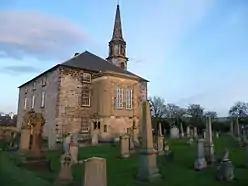 St Michael's Parish Church, Inveresk | |
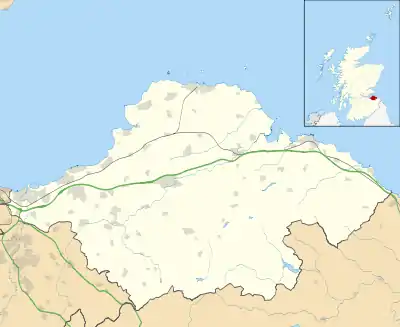 Inveresk 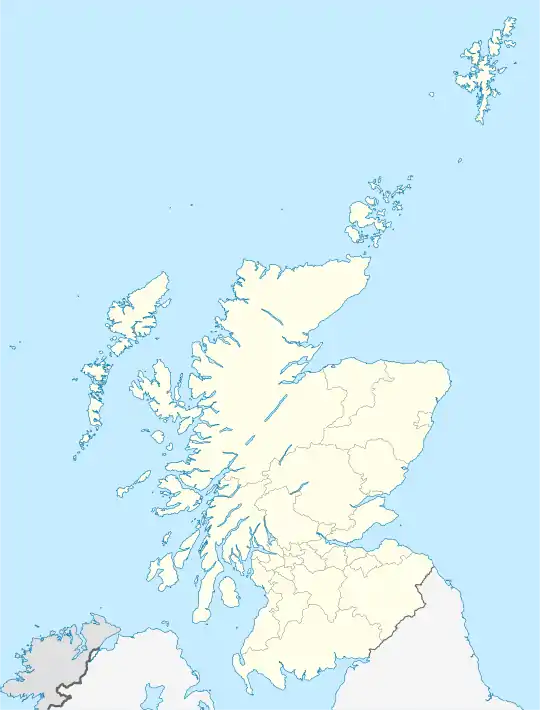 Inveresk Location within Scotland | |
| OS grid reference | NT346719 |
| Civil parish |
|
| Council area | |
| Lieutenancy area | |
| Country | Scotland |
| Sovereign state | United Kingdom |
| Post town | MUSSELBURGH |
| Postcode district | EH21 |
| Dialling code | 0131 |
| Police | Scotland |
| Fire | Scottish |
| Ambulance | Scottish |
| UK Parliament | |
| Scottish Parliament | |
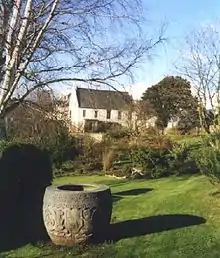
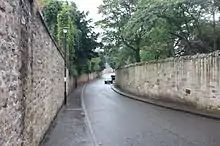
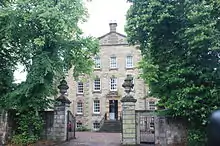
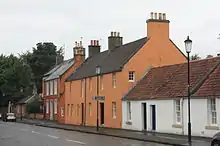
The element "Inver", from the Gaelic inbhir, refers to the confluence of the river Esk with the Firth of Forth.[3]
The village was formerly in the Midlothian parish of Inveresk and developed separately from the burgh of Musselburgh.
History
Inveresk has a fine street of 17th- and 18th-century houses. Inveresk Lodge is now privately leased, but the adjacent Inveresk Lodge Garden belongs to the National Trust for Scotland, and its west facing gardens overlooking the river Esk are open to the public. This was formerly the mansion of James Wedderburn who had made his fortune as a slave-owning sugar plantation owner in Jamaica. When his son by one of his slaves, Robert Wedderburn, travelled to Inveresk to claim his kinship he was insultingly rejected by his father who gave him some small beer and a broken or bent sixpence. This experience turned Robert Wedderburn to radicalism.
The war memorial, south of the church, was designed by Sir Robert Lorimer in 1920.[4]
St. Michael's Church
The village is dominated by St. Michael's church that stands at its west end on the summit of a hill overlooking Musselburgh. Its graveyard/cemetery stretches westwards for almost 300m and is split into separate walled sections (marking its various stages of extension) which can be broadly bracketed as original (mainly 18th century), a late Victorian extension, an Edwardian/ early 20th century extension to the north, and a modern section to the far west.
The current church is by Robert Nisbet and dates to 1805 and has a stone spire of Wren-influence.[5]
Noteworthy graves
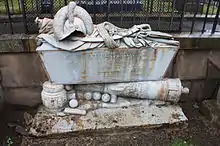
The graveyard has a number of interesting graves:-
- Edwin Alexander RSA RSW (1870-1926) artist, son of the artist Robert Alexander
- William Lindsay Alexander FRSE (1808-1884) theologian
- John Brunton (manufacturer) (1837-1917) specialist wire-maker whose family created the Brunton Theatre
- A white-painted, cast-iron sculpture of a coffin draped in military regalia, atop a full-sized cannon and cannon-balls, just south of the church marking the grave of Major William Norman Ramsay of Waterloo fame (see separate article Order of battle of the Waterloo Campaign)
- A monument to 7 fishermen from Fisherrow of the fishing-boat "Alice" from Boddam, Aberdeenshire, lost in the storm of 14 October 1881 (generally referred to as the Eyemouth Disaster).
- Very Rev Alexander Carlyle (1722-1805)
- Curious cubic gravestones to Admiral Archibald Cochran (d.1843) and his son Admiral Thomas Cochran (d.1888)
- Rev William Lindsay Alexander (1808-1884)
- John Cran, shipbuilder (1849-1940)
- Sir Charles Dalrymple, 1st Baronet
- Mark Dalrymple, 3rd Baronet (1915-1971)
- Sir Charles Dalrymple Fergusson, 5th Baronet
- The Buller-Elphinstone tomb: William Elphinstone, 15th Lord Elphinstone, Sidney Elphinstone, 16th Lord Elphinstone (a sarcophagus-style monument at the east end of the Victorian section)
- James Greenlees (1870-1951) rugby player and scholar, headmaster of Loretto College 1926-41 (a stone on the west wall of the Victorian section)
- A large monument to several of Hope Baronets of Craighall (against the far east wall), including Sir Archibald Hope, 9th Baronet
- Major General Sir Patrick Lindesay (1778-1839), military hero, Acting Governor of New South Wales in 1831 (stone fully obscured by yew trees)
- John Grieve: John Grieve was awarded the Victoria Cross for his bravery at the Battle of Balaclava in the Crimean War.
- Admiral Sir David Milne 1763-1845, his son Admiral Sir Alexander Milne 1806-1896 and his geologist son David Milne-Home 1805-1890
- David Rae, Lord Eskgrove (1724-1804) (on the outer south-west corner of the church)
- Sir William Rae, 3rd Baronet (1769-1842) son of the above, buried with his father
- Pte Alexander Sinclair (1896-1915), a survivor of the Quintinshill rail disaster near Gretna Green, the worst rail disaster in British history, killed at Gallipoli a few months later
- Major Robert Vernor (d.1827) wounded whilst a Captain of the Scots Greys at the Battle of Waterloo[6]
- Alexander Handyside Ritchie sculptor (1804-1870)
- The Wedderburn tomb: Sir David Wedderburn, 1st Baronet (1775-1858), Sir John Wedderburn, 2nd Baronet, Sir David Wedderburn, 3rd Baronet (1835-1882)
Other notable persons linked to Inveresk
- Mary Levison served as Deaconess in St Michael's Church in Inveresk from 1954,[7] and was the first person to petition the Church of Scotland for the ordination of women to the Ministry of Word and Sacrament in 1963.
- James Murray, 2nd Duke of Atholl, buried here.
- Robert Mylne, architect/master mason, 1633-1710, lived and died here
- Clarissa Dickson Wright the chef and broadcaster lived here until her death in March 2014.[8]
- Henry Yule (1820-1899), Scottish Orientalist, born here
External links
| Wikimedia Commons has media related to Inveresk. |
References
- Citations
- Groome 1882, p. 296.
- Burnet,JEM (1999) A reason for Inveresk. Courtyard Press, Inveresk. ISBN 0-9537450-0-7
- Dixon, Norman. "The Placenames of Midlothian" (PDF). Archived from the original (PDF) on 27 August 2011. Retrieved 4 July 2012. "'The mouth of the R. Esk' v. G. inbhir, inbhear: 'the confluence of a stream with the sea.'"
- Dictionary of Scottish Architects: Robert Lorimer
- McWilliam, Colin (1978). Buildings of Scotland Lothian except Edinburgh. Penguin Books.
- http://glosters.tripod.com/allwat.htm
- "Obituary: Rev. Mary Levison, minister of the Church of Scotland". www.scotsman.com. Retrieved 13 January 2020.
- Dickson Wright, Clarissa (2012). Clarissa's England: A gamely gallop through the English counties. Hodder & Stoughton. ISBN 9781444729139.
- Sources
- Carlyle, Alexander (1791). "Parish of Inveresk". The statistical account of Scotland. Drawn up from the communications of the ministers of the different parishes. 16. Edinburgh: W. Creech. pp. 1–19. Retrieved 1 July 2020.
- Groome, Francis, Hindes (1882). "Inveresk". Ordnance gazetteer of Scotland : a survey of Scottish topography, statistical, biographical, and historical. 2. Edinburgh: T.C. Jack. pp. 296-297. Retrieved 6 June 2020.
- Lewis, Samuel (1851). "Inveresk". A topographical dictionary of Scotland, comprising the several counties, islands, cities, burgh and market towns, parishes, and principal villages, with historical and statistical descriptions: embellished with engravings of the seals and arms of the different burghs and universities. 1. London: S. Lewis and co. pp. 586-587. Retrieved 6 June 2020.
- Moodie, Leslie; Beveridge, J. G. (1845). "Parish of Inveresk". The new statistical account of Scotland. [electronic resource]. Edinburgh and London: William Blackwood and Sons. pp. 246–304. Retrieved 1 July 2020.
- Scott, Hew (1915). Fasti ecclesiae scoticanae; the succession of ministers in the Church of Scotland from the reformation. 1. Edinburgh: Oliver and Boyd. pp. 324–328. Retrieved 27 February 2019.